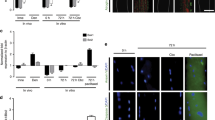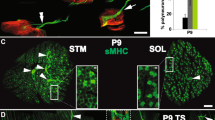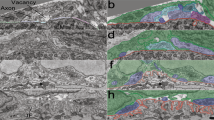Abstract
The acetylcholine receptors (AChRs) at the neuromuscular junctions of mature innervated muscle are distinguished, in part, from extrajunctional receptors of embryonic muscle fibres by their metabolic stability1–5 and high concentration at the tops of the postjunctional folds6,7. After denervation, the rate of degradation of receptors at the neuromuscular junction progressively increases8–12 even though their local concentration does not change7,8,11. Two alternatives suggest themselves—there may be a simultaneous, progressive increase in degradation rate of all junctional receptors after denervation, or the increase may reflect the composite behaviour of two populations of junctional receptors with different metabolic stabilities: those existing before denervation (‘original AChRs’) and those inserted afterwards (‘new AChRs’). Our study has been designed to distinguish between these possibilities. We have now found that up to 8–10 days after denervation, the original receptors have a degradation half life of about 8 days which is indistinguishable from that of innervated junctional receptors. After that time, their degradation half life increases to about 2.5 days. However, all new AChRs, introduced at junctional sites after denervation, have a half life characteristic of extrajunctional receptors (about 1 day). Our data thus support the hypothesis of a composite population of receptors at denervated neuromuscular junctions.
This is a preview of subscription content, access via your institution
Access options
Subscribe to this journal
Receive 51 print issues and online access
$199.00 per year
only $3.90 per issue
Buy this article
- Purchase on Springer Link
- Instant access to full article PDF
Prices may be subject to local taxes which are calculated during checkout
Similar content being viewed by others
References
Chang, C. C. & Huang, M. C. Nature 253, 643–644 (1975).
Heinemann, S., Merlie, J. & Lindstrom, J. Nature 274, 65–68 (1978).
Reiness, C. G., Weinberg, C. B. & Hall, Z. W. Nature 274, 68–70 (1978).
Berg, D. K. & Hall, Z. W. J. Physiol., Lond. 252, 771–789 (1975).
Fambrough, D. M. Physiol Rev. 59, 165–227 (1979).
Fertuck, H. C. & Salpeter, M. M. J. Cell Biol. 69, 144–158 (1976).
Porter, C. W. & Barnard, E. A. Expl Neurol. 48, 542–550 (1975).
Loring, R. & Salpeter, M. M. Proc. natn. Acad. Sci. U.S.A. 77, 2293–2297 (1980).
Brett, T. S. & Younkin, S. G. Neurosci. Abstr. 5, 2568 (1979).
Loring, R. H. & Salpeter, M. M. J. Cell Biol. 83, 137a (1979).
Loring, R. H. & Salpeter, M. M. Neurosci. Abstr. 4, 1930 (1978).
Levitt, T. A., Loring, R. H. & Salpeter, M. M. Science 210, 4469 (1980).
Chang, C. C. & Lee, C. Y. Archs int. Pharmacodyn. Thér. 144, 241–257 (1963).
Lee, C. Y., Tseng, L. F. & Chiu, T. H. Nature 215, 1177–1178 (1967).
Linden, C. D. & Fambrough, D. M. Neurosci. Abstr. 4, 527–538 (1978).
Gardner, J. M. & Fambrough, D. M. Cell 16, 661–674 (1979).
Fertuck, H. C., Woodward, W. & Salpeter, M. M. J. Cell Biol. 66, 209–213 (1975).
Merlie, J. P., Changeux, J. P. & Gros, F. Nature 264, 74–76 (1976).
Devreotes, P. N. & Fambrough, D. M. J. Cell Biol. 65, 335–358 (1975).
Karnovsky, M. J. & Roots, L. J. Histochem. Cytochem. 12, 219–221 (1964).
Frank, E., Gautvik, K. & Sommerschild, H. Acta physiol. scand. 95, 66–76 (1975).
Steinbach, J. H., Merlie, J., Heinemann, S. & Bloch, R. Proc. natn. Acad. Sci. U.S.A. 76, 3547–3551 (1979).
Burden, S. Devl Biol. 61, 79–85 (1977).
Burden, S. Devl Biol. 57, 317–329 (1977).
Burden, S. J., Sargent, P. B. & McMahan, U. J. J. Cell Biol. 82, 412–425 (1979).
Marshall, L. M., Sanes, J. R. & McMahan, U. J. Proc. natn. Acad. Sci. U.S.A. 74, 3073–3077 (1977).
McMahan, U. J., Sanes, J. R. & Marshall, L. M. Nature 271, 172–174 (1978).
Author information
Authors and Affiliations
Rights and permissions
About this article
Cite this article
Levitt, T., Salpeter, M. Denervated endplates have a dual population of junctional acetylcholine receptors. Nature 291, 239–241 (1981). https://doi.org/10.1038/291239a0
Received:
Accepted:
Issue Date:
DOI: https://doi.org/10.1038/291239a0
This article is cited by
-
Lithium causes differential effects on postsynaptic stability in normal and denervated neuromuscular synapses
Scientific Reports (2021)
-
Turnover of acetylcholine receptors at the endplate revisited: novel insights into nerve-dependent behavior
Journal of Muscle Research and Cell Motility (2015)
-
Regulation of nicotinic acetylcholine receptor turnover by MuRF1 connects muscle activity to endo/lysosomal and atrophy pathways
AGE (2013)
-
Metabolic stabilization of endplate acetylcholine receptors regulated by Ca2+ influx associated with muscle activity
Nature (1991)
-
Abnormal responses to succinylcholine and pancuronium in a patient with hemiparesis
The Italian Journal of Neurological Sciences (1990)
Comments
By submitting a comment you agree to abide by our Terms and Community Guidelines. If you find something abusive or that does not comply with our terms or guidelines please flag it as inappropriate.



